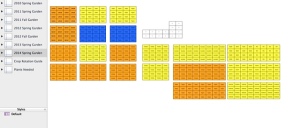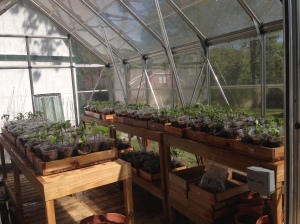Today and tomorrow (despite the cold) the boys and I will be starting our spring garden seedlings in the greenhouse! Every year I do a garden layout in Numbers so we will know how many seedlings we will need.
Last year we ended up with about 750 tomato and pepper seedlings. 
We start with newspaper pots we make using The PotMaker. 
When the seedlings are big enough, I transfer them into plastic cups so they can grow just a little bit bigger before they are planted.
It’s quite a chore to raise our own seedlings, but if you consider the fact that we planted over 100 pepper plants last spring, buying them at the store at $3-$4 each just really isn’t feasible. And that’s just the peppers! We also planted 64 tomato plants, along with a whole bunch of other plants like okra, squash, zucchini, etc.
Since we are homeschooling for the first time this season, I’m trying to figure out ways to incorporate gardening into our lessons more. Here’s what I have so far…
Science – I found this really cool interactive website at Exploratorium. And I found this great video about the science of gardening.
http://www.youtube.com/watch?v=fZw0ow9RZRo
History – We use mostly heirloom seeds which generally have to be unaltered genetically for at least 50 years. The Smithsonian has a cool resource on the history of gardening in America. I like this website about gardening in early America too.
Economics – Simply from our family’s perspective, I want Corbin to see how we save money by growing a garden. There is a lot of debate about whether or not having a garden can save a family money. There is no debate in my mind that our garden saves us a ton of money. We combine food preservation, seed saving, and recycling to get the most bang for our buck. So for me, the question isn’t whether or not you save money by gardening, but do you personally have the self-discipline to put forth the effort to make it a profitable endeavor. We are getting better and better at this every year.
Religion – Gardening references are all over the place in the bible. From a personal standpoint, I can see how easy it would be for early Christians to understand the nature of God from a gardening perspective in a pre-grocery-store world. When you have a garden, you understand insect plagues, droughts, and plant disease blights, from a whole different perspective.
Math – With the square-foot gardening we do, there is a lot of basic math involved, but there’s a little bit of geometry in there too.
Computer Science – I’m a geek, so I do a lot of my planning and research using a computer. I want to teach Corbin to use spreadsheets in every day life for planning.
Chemistry – As much as we really, really try to have a perfectly chemical-free garden, the reality is that at some point in every season we do have to use some pesticides and fertilizer. There are a ton of chemistry lesson opportunities here. There’s also chemistry in the nutrients required by plants, soil quality, photosynthesis… I could go on and on.
Art/Literature – I wasn’t raised around a garden, so one of the things I was most impressed by was the beauty of the thing. I can’t fathom anything prettier than an okra blossom! Plants have been the muse for artists and poets since there were artists and poets. We are fortunate to have a garden sun deck that allows us to sit among the plants on warm sunny days and read too.
For more information about our gardening shenanigans, check out my Gardening Blog.
